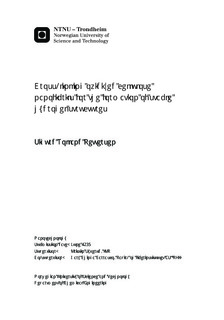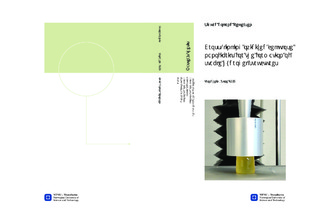| dc.description.abstract | The main goal of this project was to investigate whether the elastic properties of microfibrillated cellulose (MFC) suspensions pre-treated by TEMPO-mediated oxidation could be controlled by inducing cross-links between the nanofibrils with short diamines. Using conductometric titration, the total carboxylate and aldehyde content in the MFC was measured as 0.810 mmol/g MFC and 0.181 mmol/g MFC, respectively.The viscoelastic properties of the MFC were investigated by dynamic measurements. The MFC showed a viscoelastic response for strains approximately < 0.04, and gel-like behavior (G? > G??, δ constant and < 45°) for frequencies from 0.01 ? 10 Hz. The storage modulus for 0.80% MFC was approximately 125 Pa, and the storage modulus showed a power law dependence on concentration with a power of approximately three. Viscosity measurements showed that the MFC exhibited pseudoplastic (shear-thinning) behavior. The viscosity did not follow the Cox-Merz rule, with the dynamic viscosity being approximately ten times higher than the steady state viscosity when ω = γ̇. Upon addition of hexamethylenediamine (HMDA) without heating the sample, both viscosity and storage modulus decreased. When the temperature was increased to 80° C, the storage modulus increased rapidly to a plateau of approximately 1375 Pa in a sample with 0.80% MFC and 3.05 mmol HMDA/g MFC.Small, cylindrical gels were successfully cast at a concentration of 0.80% MFC with different concentrations of HMDA and ethylenediamine (EDA) at 80° C. Young?s modulus was measured by longitudinal compression, and correlated well with increasing cross-linker concentrations before reaching plateau values at approximately thirty times more amine than aldehyde. The gels with HMDA were almost twice as strong as the gels with EDA. Young?s modulus was largest (approximately 3220 Pa) at HMDA concentrations of 3.05 mmol/g MFC. There was a clear color change from the grey color of the regular MFC to a yellow-brown color, correlating with both cross-linker concentration and measured Young?s modulus. When the non-toxic reduction agent 2-picoline-borane was added to the gels prior to casting, no color change was visible, but the gels reached almost equal Young?s moduli.Some of the cast gels were freeze-dried, and revealed a sheet-like pore structure under scanning electron microscope (SEM) imaging. The freeze dried gels showed water absorption values of approximately 8000% for pure MFC gels and 4000% for gels with HMDA.Films were also prepared with only MFC and with concentrations of cross-linkers equal to those in the cast gels. These were imaged with laser profilometry (LP) and atomic force microscopy (AFM), and the images were analyzed for a correlation between surface roughness and cross-linker concentration. No significant correlation was observed in the AFM images, but the LP images showed a higher surface roughness at the highest cross-linker concentrations. | nb_NO |

